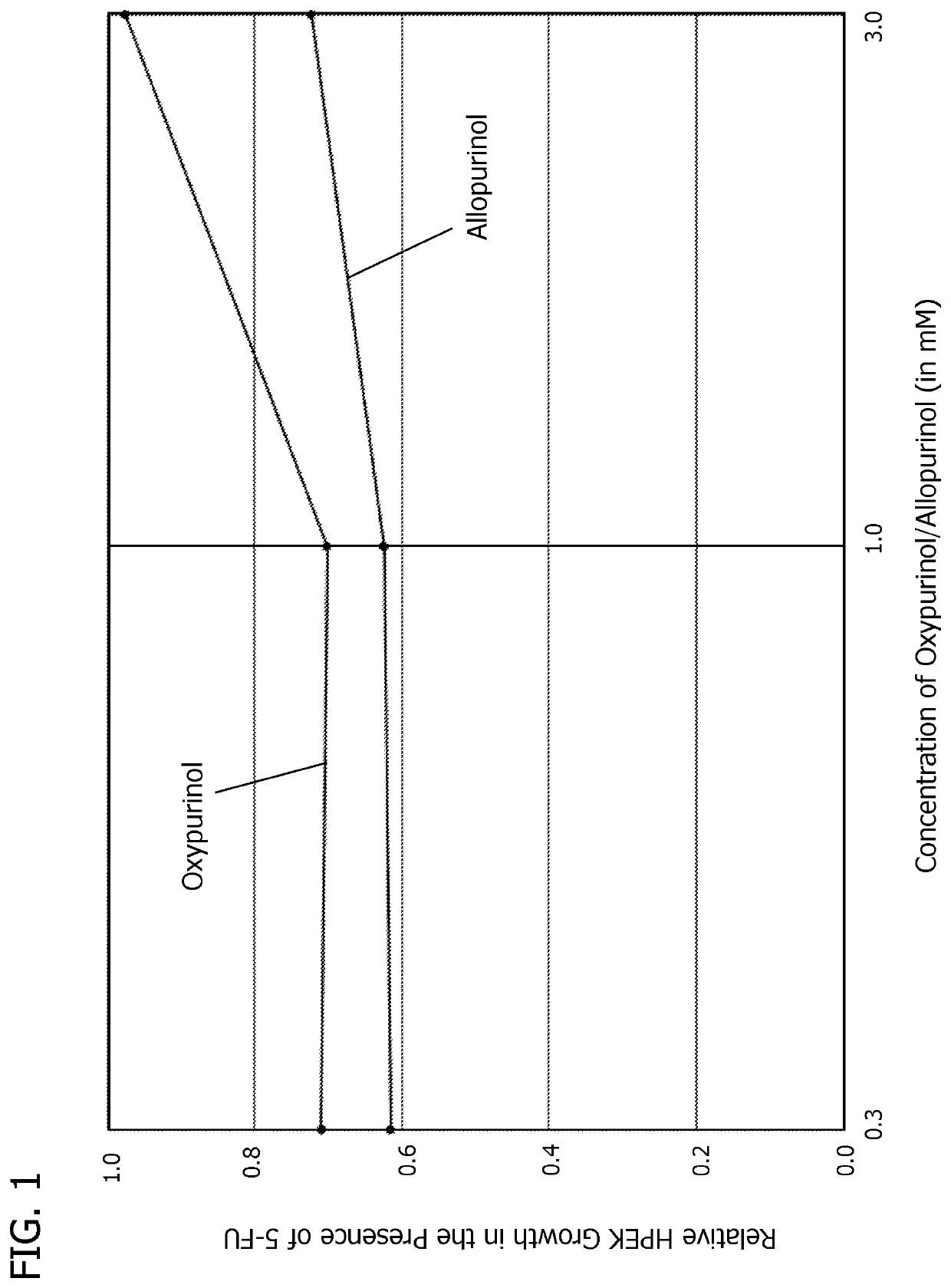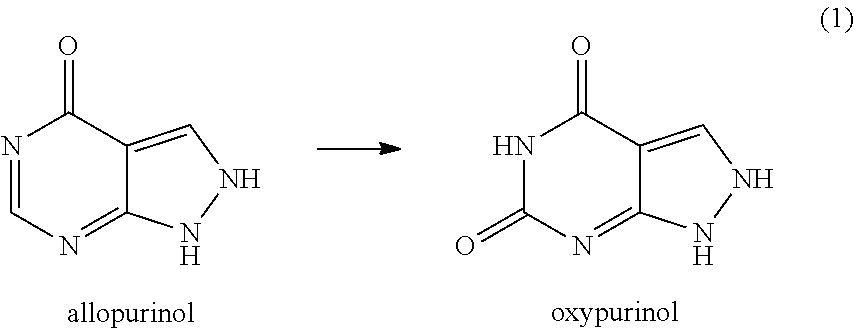Compositions and methods for treatment of the side-effects associated with administration of therapeutic agents
a technology of side effects and compositions, applied in the direction of antineoplastic agents, pharmaceutical delivery mechanisms, medical preparations, etc., can solve the problems of nhek cells showing an increase in cellular toxicity, and achieve the effects of reducing cell growth, negligible increase in cell death, and effective preventive of 5-fu-induced toxicity
- Summary
- Abstract
- Description
- Claims
- Application Information
AI Technical Summary
Benefits of technology
Problems solved by technology
Method used
Image
Examples
example 1
[0071]In one set of experiments, the results of which are shown in Table 1, proliferating HGEP cells, commonly used to assess oral mucosal toxicity, were exposed to the clinically-relevant dose of 10 μM of 5-FU and different concentrations of oxypurinol, either alone or with different concentrations of adenine or uracil, using standard tissue culture methods and incubated at 37° C. Oxypurinol concentrations of 0.03 mM, 0.1 mM, and 0.3 mM were tested. Adenine and uracil concentrations of 0.1 mM and 0.3 mM were tested. The relative viability of the cells was determined after 120 hours.
TABLE 1Proliferating HGEP cell viabilityTreatmentAVGSEMp-value1Stats2Control (0.2% DMSO) [no treatment or 5-FU]1.00000.0099ANo treatment [5-FU (10 μM)]0.62170.01441DEOxypurinol (0.03 mM) [no 5-FU]0.87920.0170ABCOxypurinol (0.1 mM) [no 5-FU]0.71340.04710.5772BCDOxypurinol (0.3 mM) [no 5-FU]0.63670.03641DEOxypurinol (0.03 mM) [5-FU (10 μM)]0.64410.02381DEOxypurinol (0.1 mM) [5-FU (10 μM)]0.75400.01360.1375...
example 2
[0074]In another set of experiments, the results of which are shown in Table 2, proliferating HPEK cells, commonly used to assess skin tissue toxicity, were exposed to the clinically-relevant dose of 10 μM of 5-FU and different concentrations of oxypurinol, either alone or with different concentrations of adenine or uracil, using standard tissue culture methods and incubated at 37° C. Oxypurinol concentrations of 0.03 mM, 0.1 mM, and 0.3 mM were tested. Adenine and uracil concentrations of 0.1 mM and 0.3 mM were tested. The relative viability of the cells was determined after 120 hours.
TABLE 2Proliferating HPEK cell viabilityTreatmentAVGSEMp-value1Stats2Control (0.2% DMSO) [no treatment or 5-FU]1.00000.0085ABNo treatment [5-FU (10 μM)]0.65070.01501DEOxypurinol (0.03 mM) [no 5-FU]1.07630.0054AOxypurinol (0.1 mM) [no 5-FU]0.79610.10600.0447CDOxypurinol (0.3 mM) [no 5-FU]1.02010.0100ABOxypurinol (0.03 mM) [5-FU (10 μM)]0.69030.01500.9992CDEOxypurinol (0.1 mM) [5-FU (10 μM)]0.79610.0109...
example 3
[0076]In yet another set of experiments, the results of which are shown in Table 3, confluent HPEK cells were exposed to the clinically-relevant dose of 10 μM of 5-FU and different concentrations of oxypurinol or allopurinol, either alone or with different concentrations of adenine, using standard tissue culture methods and incubated at 37° C. Oxypurinol and allopurinol concentrations of 0.3 mM, 1.0 mM, and 3.0 mM, which are ten times higher than those used in the first set of experiments, were tested. An adenine concentration of 0.3 mM, which was the higher concentration used in the first set of experiments, was tested. The relative viability of the cells was determined after 120 hours.
TABLE 3Confluent HPEK cell viabilityTreatmentAVGSEMStats1Stats2Control [no treatment or 5-FU]1.00000.0240DANo treatment [5-FU (10 μM)]0.64210.0291GCOxypurinol (0.3 mM) [no 5-FU]1.01830.0406DOxypurinol (1.0 mM) [no 5-FU]1.07060.0236CDOxypurinol (3.0 mM) [no 5-FU]0.83510.0154EAllopurinol (0.3 mM) [no 5...
PUM
| Property | Measurement | Unit |
|---|---|---|
| doubling time | aaaaa | aaaaa |
| concentration | aaaaa | aaaaa |
| swelling | aaaaa | aaaaa |
Abstract
Description
Claims
Application Information
 Login to View More
Login to View More - R&D
- Intellectual Property
- Life Sciences
- Materials
- Tech Scout
- Unparalleled Data Quality
- Higher Quality Content
- 60% Fewer Hallucinations
Browse by: Latest US Patents, China's latest patents, Technical Efficacy Thesaurus, Application Domain, Technology Topic, Popular Technical Reports.
© 2025 PatSnap. All rights reserved.Legal|Privacy policy|Modern Slavery Act Transparency Statement|Sitemap|About US| Contact US: help@patsnap.com



